
A binary asteroid is a system of two asteroids orbiting their common barycenter. The binary nature of 243 Ida was discovered when the Galileo spacecraft flew by the asteroid in 1993. Since then numerous binary asteroids and several triple asteroids have been detected.

1620 Geographos, provisional designation 1951 RA, is a highly elongated, stony asteroid, near-Earth object and potentially hazardous asteroid of the Apollo group, with a mean-diameter of approximately 2.5 km (1.6 mi). It was discovered on 14 September 1951, by astronomers Albert George Wilson and Rudolph Minkowski at the Palomar Observatory in California, United States. The asteroid was named in honor of the National Geographic Society.
2063 Bacchus, provisional designation 1977 HB, is a stony asteroid and near-Earth object of the Apollo group, approximately 1 kilometer in diameter. The contact binary was discovered on 24 April 1977, by American astronomer Charles Kowal at the Palomar Observatory in California, United States. It was named after Bacchus from Roman mythology.
(35396) 1997 XF11, provisional designation 1997 XF11, is a kilometer-sized asteroid, classified as a near-Earth object, Mars-crosser and potentially hazardous asteroid of the Apollo group.

1566 Icarus is a large near-Earth object of the Apollo group and the lowest numbered potentially hazardous asteroid. It has is an extremely eccentric orbit (0.83) and measures approximately 1.4 km (0.87 mi) in diameter. In 1968, it became the first asteroid ever observed by radar. Its orbit brings it closer to the Sun than Mercury and further out than the orbit of Mars, which also makes it a Mercury-, Venus-, and Mars-crossing asteroid. This stony asteroid and relatively fast rotator with a period of 2.27 hours was discovered on 27 June 1949, by German astronomer Walter Baade at the Palomar Observatory in California. It was named after the mythological Icarus.
4486 Mithra, is an eccentric asteroid and suspected contact-binary, classified as near-Earth object and potentially hazardous asteroid, approximately 2 kilometers in diameter. It belongs to the Apollo group of asteroids and is a relatively slow rotator.
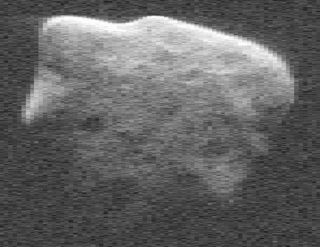
(53319) 1999 JM8 is an asteroid, slow rotator and tumbler, classified as a near-Earth object and potentially hazardous asteroid (PHA) of the Apollo group, approximately 7 kilometers (4 miles) in diameter, making it the largest PHA known to exist. It was discovered on 13 May 1999, by astronomers of the Lincoln Near-Earth Asteroid Research at the Lincoln Laboratory's Experimental Test Site near Socorro, New Mexico.
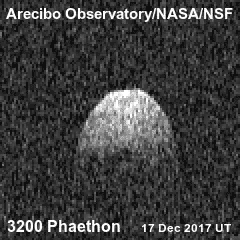
3200 Phaethon, provisionally designated 1983 TB, is an active Apollo asteroid with an orbit that brings it closer to the Sun than any other named asteroid. For this reason, it was named after the Greek myth of Phaëthon, son of the sun god Helios. It is 5.8 km (3.6 mi) in diameter and is the parent body of the Geminids meteor shower of mid-December. With an observation arc of 35+ years, it has a very well determined orbit. The 2017 Earth approach distance of about 10 million km was known with an accuracy of ±700 m.

3752 Camillo is an inclined contact-binary asteroid, classified as near-Earth object of the Apollo group, approximately 2.3 kilometers in diameter. It was discovered on 15 August 1985, by astronomers Eleanor Helin and Maria Barucci using a 0.9-metre (35 in) telescope at the CERGA Observatory in Caussols, France. Lightcurve studies by Petr Pravec in 1998 suggest that the assumed S-type asteroid has an elongated shape and a longer-than average rotation period of 38 hours.
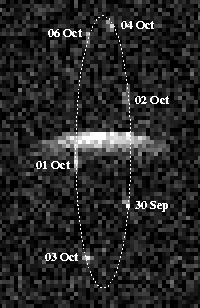
(185851) 2000 DP107 is a sub-kilometer sized asteroid, classified as potentially hazardous asteroid and near-Earth object of the Apollo group that is notable because it provided evidence for binary asteroids in the near-Earth population. The PROCYON probe developed by JAXA and the University of Tokyo was intended to flyby this asteroid before its ion thruster failed and could not be restarted.
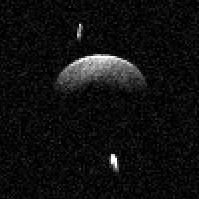
(153591) 2001 SN263 is a carbonaceous trinary asteroid, classified as near-Earth object and former potentially hazardous asteroid of the Amor group, approximately 2.6 kilometers (1.6 miles) in diameter. It was discovered by the Lincoln Near-Earth Asteroid Research project at Lincoln Lab's Experimental Test Site in Socorro, New Mexico, on 20 September 2001. The two synchronous minor-planet moons measure approximately 770 and 430 meters and have an orbital period of 16.46 and 150 hours, respectively.

3122 Florence is a stony trinary asteroid of the Amor group. It is classified as a near-Earth object and potentially hazardous asteroid. It measures approximately 5 kilometers in diameter. It orbits the Sun at a distance of 1.0–2.5 AU once every 2 years and 4 months ; the orbit has an eccentricity of 0.42 and an inclination of 22° with respect to the ecliptic. Florence has two moons.
(7025) 1993 QA is a sub-kilometer asteroid classified as near-Earth object of the Apollo and Amor group, respectively. It was discovered on 16 August 1993, by astronomers of the Spacewatch program at the Kitt Peak National Observatory near Tucson, Arizona, United States. The asteroid measures approximately half a kilometer in diameter and has a short rotation period of 2.5057 hours.
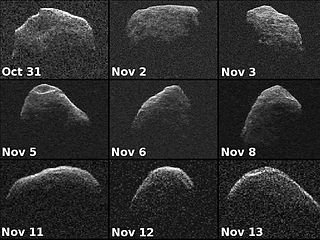
(214869) 2007 PA8 is an asteroid and slow rotator, classified as near-Earth object and potentially hazardous asteroid of the Apollo group, approximately 1.4 kilometers in diameter.
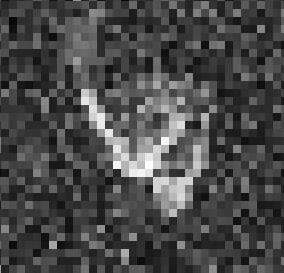
(192642) 1999 RD32, provisional designation: 1999 RD32, is an asteroid and suspected contact binary on an eccentric orbit, classified as a large near-Earth object and potentially hazardous asteroid of the Apollo group, approximately 5 kilometers (3 miles) in diameter. It was discovered on 8 September 1999, at a magnitude of 18, by astronomers of the LINEAR program using its 1-meter telescope at the Lincoln Laboratory's Experimental Test Site near Socorro, New Mexico, United States. The asteroid is likely of carbonaceous composition and has a rotation period of 17.08 hours.

(341843) 2008 EV5, provisional designation 2008 EV5, is a sub-kilometer asteroid, classified as a near-Earth object and potentially hazardous asteroid of the Aten group, approximately 400 metres (1,300 feet) in diameter. It was discovered on 4 March 2008, by astronomers of the Mount Lemmon Survey at Mount Lemmon Observatory near Tucson, Arizona, United States.

(505657) 2014 SR339, provisional designation 2014 SR339, is a dark and elongated asteroid, classified as near-Earth object and potentially hazardous asteroid of the Apollo group, approximately 970 meters (3,200 feet) in diameter. It was discovered on 30 September 2014, by NASA's Wide-field Infrared Survey Explorer telescope (WISE) in Earth's orbit. Closely observed at Goldstone and Arecibo in February 2018, it has a rotation period of 8.7 hours.
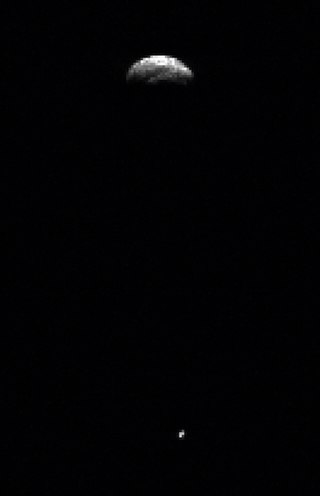
2005 LW3 is a binary near-Earth asteroid classified as a potentially hazardous object of the Apollo group. It was discovered on 5 June 2005 by the Siding Spring Survey at Siding Spring Observatory in Australia. It made a close approach of 2.97 lunar distances (1.14×10^6 km; 0.71×10^6 mi) from Earth on 23 November 2022, reaching a peak brightness of apparent magnitude 13 as it passed over the northern celestial hemisphere sky. It was extensively observed by astronomers worldwide during the close approach, and radar observations by NASA's Goldstone Solar System Radar in California discovered a 100 m (330 ft)-wide natural satellite orbiting the asteroid at a wide separation of 4 km (2.5 mi).















